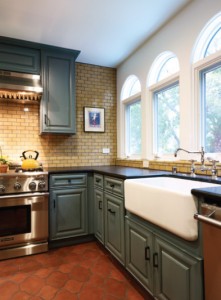The Evolution of the Kitchen Backsplash
Great and not-so-great moments from the history of kitchen backsplash design.
 The first kitchen backsplashes were functional, not decorative. They were designed to protect the walls from splatters of water, grease, tomato sauce, and other cooking and cleaning mishaps. Therefore, they tended to be quite small—often just 4 inches tall. In some homes, they were only found behind the sink and stove areas, as this was where the most protection is needed.
The first kitchen backsplashes were functional, not decorative. They were designed to protect the walls from splatters of water, grease, tomato sauce, and other cooking and cleaning mishaps. Therefore, they tended to be quite small—often just 4 inches tall. In some homes, they were only found behind the sink and stove areas, as this was where the most protection is needed.
Backsplashes Get Bigger
The first big change in the world of kitchen backsplash design was to begin viewing the backsplash as a decorative as well as a functional element. This led designers to expand the backsplash to cover more and more of the wall. First the 4-inch backsplash strip was run all the way around the kitchen, above all the countertops. Sometimes this strip was made of tile; sometimes it was the same material as the counter. By the 1950s, many homes had backsplashes running all the way up to the bottom of the upper cabinets, and today you will even see backsplash tile laid all the way up to the ceiling.
Decorative Tile Takes Over
Another big change was the popularization of decorative tile for the kitchen backsplash. Unfortunately, this has led to some looks that seem really outdated in retrospect. Just imagine a 1970s or 1980s era yellow kitchen with a yellow tile backsplash studded with accent tiles featuring fat brown mushrooms and you’ll get the picture.
It’s important to point out that decorative tile isn’t inherently a bad choice. In fact, today top designers are using decorative tile to great effect in projects for top clientele such as Scarlett Johansson. The key is to choose a decorative tile that can stand on its own aesthetic merits and is not tied to a décor fad.
Going Natural
In the 90s, there was a shift away from bold decorative tile towards more natural options. A matte stone tile in a neutral shade was often used for the majority of the backsplash, with a glossy ceramic tile or a strip of mosaic tile in a contrasting color for the border. Today we are seeing a bit of an echo of this trend as some consumers opt to use large marble or granite tiles that match their stone countertops for their backsplash.
The Rise of Subway Tile
When chronicling the history of kitchen backsplash design, we cannot fail to mention subway tile. This rectangular tile first came on the scene in a 3×5 size in the early 2000s. It provided a clean look and was often paired with a strip of mosaic tile as an accent. Today, there has been an explosion of interest in subway tile options, with an increasing range of sizes and colors available. Large-format subway tile laid in a grid (rather than offset) pattern is popular for a European look, while smaller, elongated subway tiles have come out as a way to combine the sleek look of subway tile with the visual interest of mosaic tile in one product. One very important development has been the shift away from ceramic subway tile to glass subway tile, which helps brighten under-cabinet spaces with its luminous sheen.
Wondering What to Do for Your Backsplash?
Come browse our tile showroom or speak with one of our tile design consultants for inspiration.
